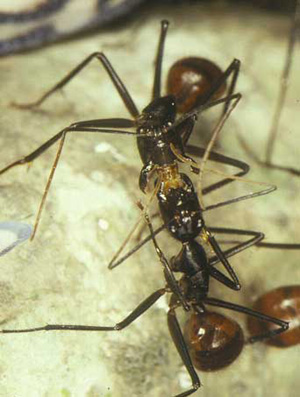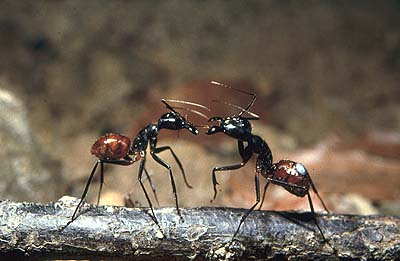
A briefing on the life history of the giant forest ant Dinomyrmex gigas (PDF)
Martin Pfeiffer, Department of Biogeography, University of Bayreuth
Dinomyrmex gigas (Latreille 1802), see Fig. 1, is one of the largest ant species of the world living in the South- East Asian rain forests, from Sumatra to Thailand. Its habitat ranges from peat swamps of the mangrove forests up to the mountain forests at 1500 m above sea level. In South Borneo it is replaced by Dinomyrmex gigas ssp. borneensis, a subspecies with yellow legs (see Fig. 2). |
 |
| Fig. 1 Liquid food exchange (oral trophallaxis) between two workers of D. gigas (Photo M. Pfeiffer, Uni Ulm). | Fig. 2 A worker of Dinomyrmex gigas borneensis from Sarawak (Photo copyright Prof. Alexander Haas, University of Hamburg). |
It is a conspicuous element of the Malaysian fauna and different scientists studied various parts of its behavior, ecology and life history (Tho, 1981; Gault, 1987; Chung and Mohamed, 1993; Levy, 1996; Orr and Charles, 1994; Orr et al., 1996, Yamane et al. 1996, Pfeiffer, 1997a,b, 1998, 2000, 2001). Camponotus gigas is a central place forager which has a polydomous colony structure, and combines efficient communication, ergonomic optimization, polyethism and effective recruitment systems to optimise its foraging yield. A subcaste of specialist transport workers carries food from peripheral nests to the central nest of the queen ( Pfeiffer and Linsenmair, 1998). The aseasonal nuptial flight pattern of C. gigas shows phase shifted reproductive cycles and a circasemiannual rhythm with a period of 188 ± 5 days, which points towards a strong endogenous component ( Pfeiffer and Linsenmair, 1997). The result is a shifting cycle of reproductive flights, so the time of mating flight is changing within years. This kind of pattern is only possible in tropical ants that live in a more or less constant environment. The territorial behavior of giant ants consists of long lasting ritual fights (see Fig. 3) between a few specialist majors that meet at fixed tournament places.

Fig. 3 Two giant ants in a stunning, ritual fight (Photo M. Pfeiffer, Uni Ulm).
A handful of ants can meet every night and fight over hours in a ritual manner. These permanent fights can last several months (Pfeiffer and Linsenmair, 2001). Interspecific territorial borders are guarded at special bridgepoints (see Fig. 4), e.g. at the tree trunks.

Fig. 4 Interspecific border between adjacent territories of Dinomyrmex gigas and an unknown Camponotus species. A major of D. gigas is protecting the tree trunc of a larger tree, thus prohibiting canopy access of the other species.
Colony structure is flexible, comprising between 8 and 14 mostly subterranean nests (Pfeiffer, 1997). Pfeiffer and Linsenmair (2000) studied the life history of D. gigas in detail, providing the following information: The best studied colony had a territory of 0.8 ha and a population of ca. 7000 workers, distributed unevenly among an average of 11 nests. Workers are bimorphic, majors on average weighed 372 mg and minors 135 mg. The castes differ in morphology particularly by allometric growth of the head (mean head width 6.93 mm and 3.56 mm). Foraging is mainly nocturnal. At dusk large numbers of foragers (between 35 and 2287) leave single nests within 75 minutes of the onset of foraging and invade the canopy. Through night time many workers commute between the canopy and the nests and all are returning home by dawn. During the daytime foraging is reduced and is restricted to a much smaller number of workers which roam the forest floor. D. gigas foragers (see Fig. 5) collect mainly honeydew (90%) with the remainder consisting of insect prey and bird droppings (Pfeiffer and Linsenmair, 2001).

Fig. 5 Workers of D. gigas are tending Flatidae
Bythopsyrna circulata adults (Photo M. Pfeiffer, Uni Ulm).
Literature
Back to the Ecology overview




